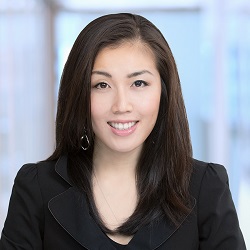The interview below is part of an ongoing effort by McGuireWoods to profile women leaders in private equity (PE). To read previous profiles, click here. To recommend a woman for a future interview, email WPEF@mcguirewoods.com.

Jennifer Ding is a principal with Welsh, Carson, Anderson and Stowe (WCAS), a PE firm focused on investing in technology and healthcare. Prior to joining WCAS, Ding worked at Permira and JMI Equity, where she led buyout and growth equity investments in technology, with a focus on enterprise software. Earlier in her career, she worked at McKinsey & Co. and Lytx, a software company in the telematics and fleet management space.
Q: What advice would you provide to a woman-led company interested in securing PE?
Jennifer Ding: Take three key steps. First, start getting to know different investors early on and learn about their investment strategy and culture because it really is different from firm to firm.
Second, really focus on spending quality time on the few firms that you find interesting and align with your strategy, rather than speaking with a bunch of people at the same time and taking time and resources away from focusing on your business.
Third, as you get closer to picking investment partners, obtain a significant number of references. Having been on both the sell and buy sides, I’ve seen a shockingly wide range of how much diligence people actually perform on the personalities involved, the various characteristics and politics of firms, and how these may apply to their portfolio companies and management teams. I think these are really big areas for diligence, other than just capital provision or a firm’s brand.
Q: What do you think is the biggest challenge facing women entrepreneurs? What advice would you provide to overcome it?
JD: The biggest challenge for women entrepreneurs is the biggest challenge for women investors and the biggest challenge for women in the corporate world in general. It is going into a room and finding that, oftentimes, your starting point in terms of level of respect, trust and how much your words will be heard is going to be lower than that of the men in the room. In the competitive business world, whether it is securing funding or starting your business and building customer relationships and partnerships, women often have that initial disadvantage they need to overcome.
You can overcome it with your knowledge and experience over time, but I think there are significant, inherent bias disadvantages because we operate in a people business and we live in a society that is inherently biased in many ways because of our evolutionary and cultural heritage.
Q: What attracted you to PE?
JD: Being able to constantly learn about different companies, industries and the latest advances in technology. I don’t think there are a lot of jobs that allow you to never have monotony. Meeting interesting people, learning about products or services I have never heard of, and constantly feeding my intellectual curiosity are probably why I started in PE. I began in a sector I had no background in, which was software. I still love it and I am still learning more every day.
Q: Why is it important for more women to pursue entrepreneurship?
JD: Women represent probably half of the economy in terms of consumer spend as well as production in a lot of industries. There are great ideas out there that men may not think of because of their experiences.
I also think more diverse teams are generally more productive. In business, it is still, unfortunately, a male-dominated environment. More women in the room means wider range of perspectives. In addition, teams with women leaders tend to attract other women, which often leads to overall increased level of creativity and productivity.
Q: Why do you actively support providing capital to women entrepreneurs?
JD: I started my investing career in software about 10 years ago. The technology industry, especially software, is really lacking in women entrepreneurs. There are, of course, companies that have women in leadership positions, but generally they did not start the companies and often they are not in the C-suite. I do think this industry would gain a lot of value from more diversity of ideas at the top.
In tech, I see a lot of companies led by similar groups of people that fall into the same traps with their organizational leadership going through execution challenges. Some of that is probably because the people in the room coming up with strategy and making decisions around processes are too similar to each other and therefore are limited in the variety of thought. If there were more diversity at the top, perhaps some companies would come to different and better decisions than what’s been done in the past by other companies led by similar groups, especially in earlier stages of their lives.
In technology, the boards are also fairly male-dominated. In these situations, sometimes you have both sides of the equation with “same think,” which is always a little dangerous.
Tech is not just coding and engineering. The much more exciting aspect of tech is applying the technical sciences and innovations to everyday life. It’s a space where I think there is a significant opportunity for women to pursue their ideas.
To contact Jennifer Ding, email jding@wcas.com.